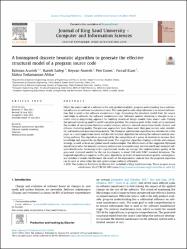| dc.contributor.author | Arasteh, Bahman | |
| dc.contributor.author | Sadegi, Razieh | |
| dc.contributor.author | Arasteh, Keyvan | |
| dc.contributor.author | Gunes, Peri | |
| dc.contributor.author | Kiani, Farzad | |
| dc.contributor.author | Torkamanian-Afshar, Mahsa | |
| dc.date.accessioned | 2023-08-11T07:56:12Z | |
| dc.date.available | 2023-08-11T07:56:12Z | |
| dc.date.issued | 2023 | en_US |
| dc.identifier.citation | ARASTEH, Bahman, Razieh SADEGI, Keyvan ARASTEH, Peri GUNES, Farzad KIANI & Mahsa TORKAMANIAN-AFSHAR. "A Bioinspired Discrete Heuristic Algorithm to Generate the Eeffective Structural Model of a Program Source Code". Journal of King Saud University – Computer and Information Sciences, 35.8 (2023): 1-17. | en_US |
| dc.identifier.uri | https://www.scopus.com/record/display.uri?eid=2-s2.0-85165894761&origin=SingleRecordEmailAlert&dgcid=raven_sc_search_en_us_email&txGid=df784e950b83422db20ce1bddd64f90a | |
| dc.identifier.uri | https://hdl.handle.net/11352/4635 | |
| dc.description.abstract | When the source code of a software is the only product available, program understanding has a substantial
influence on software maintenance costs. The main goal in code comprehension is to extract information
that is used in the software maintenance stage. Generating the structural model from the source
code helps to alleviate the software maintenance cost. Software module clustering is thought to be a
viable reverse engineering approach for building structural design models from source code. Finding
the optimal clustering model is an NP-complete problem. The primary goals of this study are to minimize
the number of connections between created clusters, enhance internal connections inside clusters, and
enhance clustering quality. The previous approaches’ main flaws were their poor success rates, instability,
and inadequate modularization quality. The Olympiad optimization algorithm was introduced in this
paper as a novel population-based and discrete heuristic algorithm for solving the software module clustering
problem. This algorithm was inspired by the competition of a group of students to increase their
knowledge and prepare for an Olympiad exam. The suggested algorithm employs a divide-and-conquer
strategy, as well as local and global search methodologies. The effectiveness of the suggested Olympiad
algorithm to solve the module clustering problem was evaluated using ten real-world and standard software
benchmarks. According to the experimental results, on average, the modularization quality of the
generated clustered models for the ten benchmarks is about 3.94 with 0.067 standard deviations. The
proposed algorithm is superior to the prior algorithms in terms of modularization quality, convergence,
and stability of results. Furthermore, the results of the experiments indicate that the proposed algorithm
can be used to solve other discrete optimization problems efficiently. | en_US |
| dc.language.iso | eng | en_US |
| dc.publisher | Elsevier | en_US |
| dc.relation.isversionof | 10.1016/j.jksuci.2023.101655 | en_US |
| dc.rights | info:eu-repo/semantics/openAccess | en_US |
| dc.subject | Olympiad optimization algorithm | en_US |
| dc.subject | Software module clustering | en_US |
| dc.subject | Cohesion | en_US |
| dc.subject | Modularization quality | en_US |
| dc.title | A Bioinspired Discrete Heuristic Algorithm to Generate the Eeffective Structural Model of a Program Source Code | en_US |
| dc.type | article | en_US |
| dc.relation.journal | Journal of King Saud University – Computer and Information Sciences | en_US |
| dc.contributor.department | FSM Vakıf Üniversitesi, Mühendislik Fakültesi, Bilgisayar Mühendisliği Bölümü | en_US |
| dc.identifier.volume | 35 | en_US |
| dc.identifier.issue | 8 | en_US |
| dc.identifier.startpage | 1 | en_US |
| dc.identifier.endpage | 17 | en_US |
| dc.relation.publicationcategory | Makale - Uluslararası Hakemli Dergi - Kurum Öğretim Elemanı | en_US |
| dc.contributor.institutionauthor | Kiani, Farzad | |



















